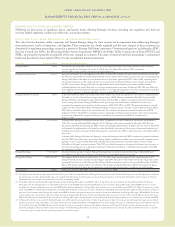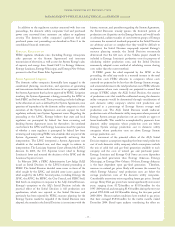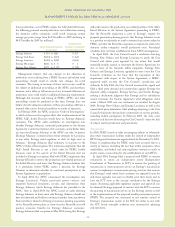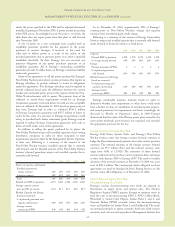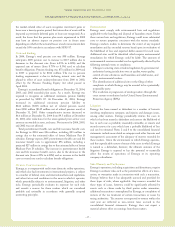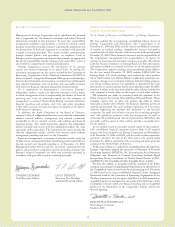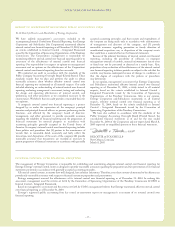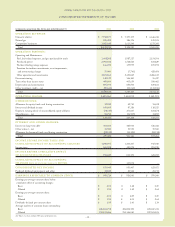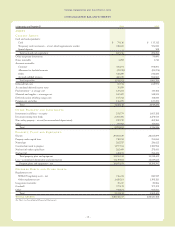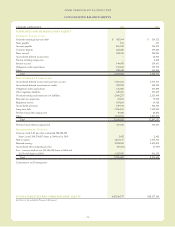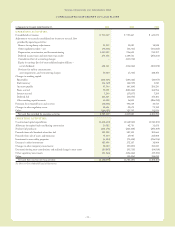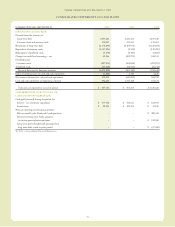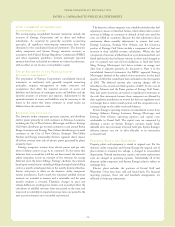Entergy 2004 Annual Report Download - page 46
Download and view the complete annual report
Please find page 46 of the 2004 Entergy annual report below. You can navigate through the pages in the report by either clicking on the pages listed below, or by using the keyword search tool below to find specific information within the annual report.
-44 -
Entergy Corporation and Subsidiaries 2004
Due to the oversupply of power that existed throughout the U.S.
and the UK in 2002, and the resulting decreases in spark spreads,
consistent with Entergy’s point of view, Entergy’s impairment tests
indicated that a number of impairments were required to be
recognized in 2002 in the Energy Commodity Services segment.
These impairments, which were also accompanied by other charges
related to the restructuring of Entergy’s independent power
business, are further detailed in Note 11 to the consolidated
financial statements.
In 2004, Entergy recorded a charge of approximately $55 million
($36 million net-of-tax) as a result of an impairment of the value of
the Warren Power plant. Entergy concluded that the value of the
plant, which is owned in the non-nuclear wholesale assets business,
was impaired. Entergy reached this conclusion based on valuation
studies prepared in connection with the Entergy Asset
Management stock sale discussed above in “Results of Operations.”
Pension and Other Postretirement Benefits
Entergysponsors defined benefit pensionplans which cover
substantially all employees. Additionally, Entergy currently provides
postretirement health care and life insurance benefits for
substantially all employees who reach retirement age while still
working for Entergy. Entergy’s reported costs of providing these
benefits, as described in Note 10 to the consolidated financial
statements, are impacted by numerous factors including the
provisions of the plans, changing employee demographics, and
various actuarial calculations, assumptions, and accounting
mechanisms. Because of the complexity of these calculations, the
long-term nature of these obligations, and the importance of
the assumptions utilized, Entergy’s estimate of these costs is a
critical accounting estimate for the U.S. Utility and Non-Utility
Nuclear segments.
Assumptions
Keyactuarial assumptions utilized in determining these
costs include:
•Discount rates used in determining the future benefit
obligations;
•Projected health care cost trend rates;
•Expected long-term rate of return on plan assets; and
•Rate of increase in future compensation levels.
Entergy reviews these assumptions on an annual basis and adjusts
them as necessary. The falling interest rate environment and worse-
than-expected performance of the financial equity markets over the
past several years have impacted Entergy’s funding and reported
costs for these benefits. In addition, these trends have caused
Entergy to make a number of adjustments to its assumptions.
In selecting an assumed discount rate to calculate benefit
obligations, Entergy reviews market yields on high-quality
corporate debt and matches these rates with Entergy’s projected
stream of benefit payments. Based on recent market trends,
Entergy reduced its discount rate used to calculate benefit
obligations from 6.75% in 2002 to 6.25% in 2003 and to 6% in
2004. Entergy reviews actual recent cost trends and projected future
trends in establishing health care cost trend rates. Based on this
review, Entergy increased its health care cost trend rate
assumption used in calculating the December 31, 2004
accumulated postretirement benefit obligation to a 10% increase in
health care costs in 2005 gradually decreasing each successive year,
until it reaches a 4.5% annual increase in health care costs in 2011
and beyond.
In determining its expected long-term rate of return on plan
assets, Entergy reviews past long-term performance, asset
allocations, and long-term inflation assumptions. Entergy targets an
asset allocation for its pension plan assets of roughly 65% equity
securities, 31% fixed-income securities, and 4% other investments.
The target allocation for Entergy’s other postretirement benefit
assets is 51% equity securities and 49% fixed income securities.
Based on recent market trends, Entergy reduced its expected
long-term rate of return on plan assets used to calculate benefit
obligations from 8.75% for 2002 and 2003 to 8.5% in 2004. The
assumed rate of increase in future compensation levels used to
calculate benefit obligations was 3.25% in 2002, 2003, and 2004.
Cost Sensitivity
The following chart reflects the sensitivity of pension cost to
changes in certain actuarial assumptions (in thousands):
Actuarial Change in Impact on 2004 Impact on Projected
Assumption Assumption Pension Cost Benefit Obligation
Increase/(Decrease)
Discount rate (0.25%) $10,268 $94,903
Rate of return
onplan assets (0.25%) $ 4,388 –
Rate of increase
in compensation 0.25% $ 4,928 $29,134
The following chart reflects the sensitivity of postretirement
benefit cost to changes in certain actuarial assumptions
(in thousands):
Impact on
Impact on 2004 Accumulated
Actuarial Change in Postretirement Postretirement
Assumption Assumption Benefit Cost Benefit Obligation
Increase/(Decrease)
Health care
cost trend 0.25% $4,150 $23,892
Discount rate (0.25%) $2,715 $28,719
Eachfluctuationabove assumes that the other components of the
calculation are held constant.
Accounting Mechanisms
In accordance with SFAS No. 87, “Employers’ Accounting for
Pensions,” Entergy utilizes a number of accounting mechanisms
that reduce the volatilityof reported pension costs. Differences
between actuarial assumptions and actual plan results are deferred
and are amortized into cost only when the accumulated differences
exceed 10% of the greater of the projected benefit obligationor the
market-related value of plan assets. If necessary, the excess is
amortized over the average remaining service period of
active employees.
Additionally, Entergy accounts for the effect of asset
performance on pension expense over a twenty-quarter phase-in
period through a “market-related” value of assets calculation. Since
MANAGEMENT’S FINANCIAL DISCUSSION and ANALYSIS continued


